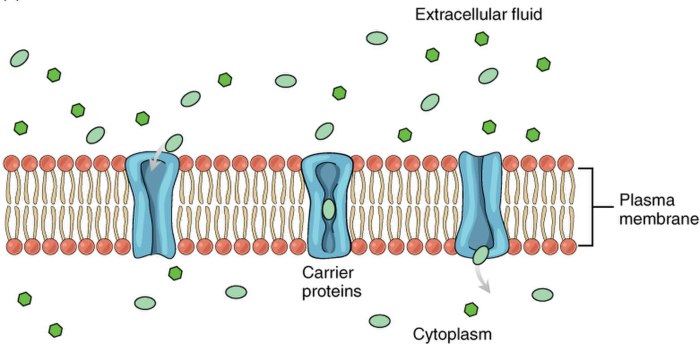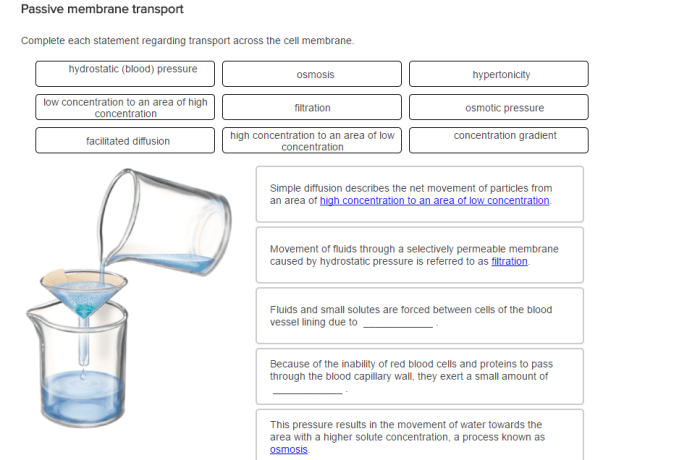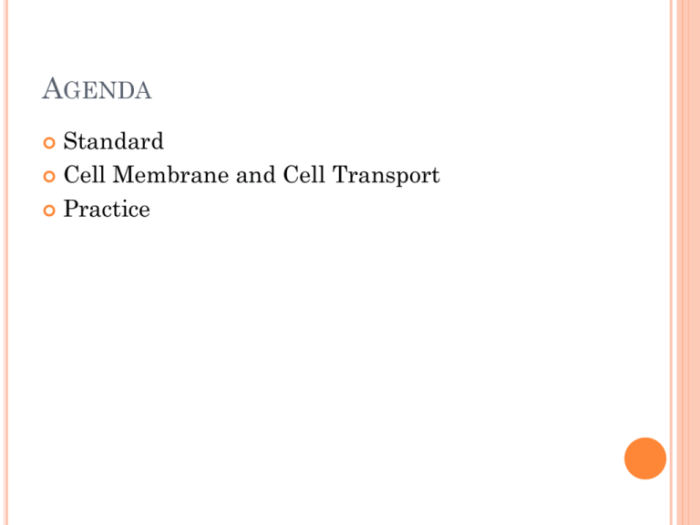Complete each statement regarding transport across the cell membrane, an essential process for cellular life, involves the movement of molecules across the cell membrane. This complex process encompasses both passive and active transport mechanisms, each playing a vital role in maintaining cellular homeostasis and facilitating essential biological functions.
The cell membrane, a selectively permeable barrier, regulates the entry and exit of substances, ensuring the cell’s proper functioning. Understanding the mechanisms of transport across the cell membrane is crucial for comprehending cellular physiology and its implications in various fields.
Types of Transport Across the Cell Membrane

Transport across the cell membrane is essential for the survival of cells. It allows cells to take in nutrients, expel waste products, and maintain homeostasis. There are two main types of transport across the cell membrane: passive transport and active transport.
Passive transport is the movement of molecules from an area of high concentration to an area of low concentration. This type of transport does not require energy. Examples of passive transport include diffusion, osmosis, and facilitated diffusion.
Active transport is the movement of molecules from an area of low concentration to an area of high concentration. This type of transport requires energy. Examples of active transport include the sodium-potassium pump and the calcium pump.
Membrane proteins play an important role in transport across the cell membrane. These proteins provide channels and carriers that allow molecules to cross the membrane.
Mechanisms of Passive Transport: Complete Each Statement Regarding Transport Across The Cell Membrane

Diffusion is the movement of molecules from an area of high concentration to an area of low concentration. This type of transport does not require energy. The rate of diffusion is determined by the concentration gradient, the temperature, and the size of the molecules.
Osmosis is a special type of diffusion that involves the movement of water across a semipermeable membrane. Water molecules move from an area of high water concentration to an area of low water concentration. Osmosis is important for maintaining cell volume and for the transport of nutrients and waste products.
Facilitated diffusion is a type of passive transport that involves the movement of molecules across the cell membrane with the help of membrane proteins. This type of transport is faster than simple diffusion and is important for the transport of large molecules, such as glucose and amino acids.
Mechanisms of Active Transport
Active transport is the movement of molecules from an area of low concentration to an area of high concentration. This type of transport requires energy. The energy for active transport is provided by ATP.
The sodium-potassium pump is an example of an active transport mechanism. This pump uses ATP to move sodium ions out of the cell and potassium ions into the cell. The sodium-potassium pump is important for maintaining the cell’s resting potential and for the transport of nutrients and waste products.
The calcium pump is another example of an active transport mechanism. This pump uses ATP to move calcium ions out of the cell. The calcium pump is important for maintaining the cell’s calcium concentration and for the regulation of cell function.
Importance of Transport Across the Cell Membrane

Transport across the cell membrane is essential for the survival of cells. It allows cells to take in nutrients, expel waste products, and maintain homeostasis.
Transport is also important for cellular metabolism. For example, the sodium-potassium pump is essential for the transport of glucose into cells. Glucose is the main source of energy for cells.
Transport across the cell membrane is also essential for life. For example, the calcium pump is essential for the regulation of heart function. The sodium-potassium pump is essential for the transmission of nerve impulses.
Regulation of Transport Across the Cell Membrane
Transport across the cell membrane is regulated by a variety of mechanisms. These mechanisms include the regulation of membrane proteins, the regulation of ATP levels, and the regulation of the concentration gradients of molecules.
Hormones and other signaling molecules can also regulate transport across the cell membrane. For example, insulin stimulates the transport of glucose into cells. Glucagon inhibits the transport of glucose into cells.
The regulation of transport across the cell membrane is essential for maintaining cellular function. For example, the regulation of the sodium-potassium pump is essential for maintaining the cell’s resting potential. The regulation of the calcium pump is essential for maintaining the cell’s calcium concentration.
Applications of Transport Across the Cell Membrane

Transport across the cell membrane is used in a variety of applications, including drug delivery, biotechnology, and genetic engineering.
Drug delivery systems are designed to deliver drugs to specific cells or tissues. These systems often use transport mechanisms to cross the cell membrane. For example, liposomes are small vesicles that can be used to deliver drugs to cells. Liposomes fuse with the cell membrane and release their contents into the cell.
Biotechnology and genetic engineering use transport mechanisms to modify cells. For example, gene therapy uses viruses to deliver genes to cells. The viruses fuse with the cell membrane and release their genetic material into the cell. The genetic material is then integrated into the cell’s DNA.
Transport across the cell membrane is also used in medical research. For example, researchers use transport mechanisms to study the function of cells. They can also use transport mechanisms to develop new drugs and treatments.
Popular Questions
What is the difference between passive and active transport?
Passive transport involves the movement of molecules across the cell membrane without the need for energy, while active transport requires energy to move molecules against their concentration gradient.
What are the different types of active transport mechanisms?
There are two main types of active transport mechanisms: primary active transport and secondary active transport. Primary active transport uses ATP to directly power the movement of molecules across the membrane, while secondary active transport uses the energy stored in ion gradients to drive the movement of other molecules.
What is the role of membrane proteins in transport?
Membrane proteins are essential for transport across the cell membrane. They provide channels or carriers that allow molecules to cross the membrane, and they can also act as pumps to move molecules against their concentration gradient.